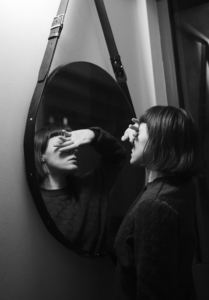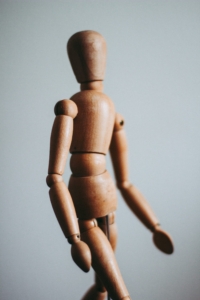Think back to when you were a child, possibly a young child, before you ever had a thought of self-consciousness about your body. Imagine the freedom and carefree sense of not feeling unworthy, anxious, or stressed about your appearance.
 God created us, yet sometimes we lose sight of the fact that he made us embodied souls. We are in our physical bodies, yet we are so much more than what we look like on the outside.
God created us, yet sometimes we lose sight of the fact that he made us embodied souls. We are in our physical bodies, yet we are so much more than what we look like on the outside.
We exist in both realities. And we fracture ourselves when we view our worth as solely existing in our bodies. We also fracture ourselves when we dismiss the reality, the constraints, and the gift of our physical being – living as though we don’t have that embodied soul, through which we experience everything around us.
Individual Christian counseling can address a wide range of struggles, and negative body image is one of those struggles. Keep reading to learn more about how to develop a positive body image, and how Christian counseling can help with low self-esteem.
Why is a positive body image difficult to achieve?
Having a negative body image is a common struggle and experience. You are not alone if you are having a hard time with how you view your appearance!
Do you find it impossible to feel completely confident in how you look? In the last few decades, social media has amplified the pressure already exerted by traditional media. Now as a culture, we have the constant immediacy of social media providing access to images of other people at any moment of the day. Our brains are bombarded with these images and it almost inevitably leads to comparison.
amplified the pressure already exerted by traditional media. Now as a culture, we have the constant immediacy of social media providing access to images of other people at any moment of the day. Our brains are bombarded with these images and it almost inevitably leads to comparison.
Although comparison has always existed (read the story of Rachel and Leah in the Old Testament), it was nowhere near the extent that it is today.
Imagine living in a small village in Israel in Bible times. It was rare you traveled more than a mile from your home. The people around you, whom you saw every day, were a relatively small group. There was a range of outward attractiveness, but you weren’t exposed to every other person from around the country and the world so you could compare yourself to them. And there was no such thing as a camera.
Again, that’s not to say that people in ancient times didn’t struggle with negative body image, but it wasn’t worsened by the inundation of social media images.
One survey found that 50% of women and 37% of men compare themselves unfavorably to media images. This survey shows us how pervasive this is, as well as the fact that both men and women struggle with this issue.
One statistic about women and body image says:
Women with a positive body image are more likely to have good physical and mental health. Girls and women with negative thoughts and feelings about their bodies are more likely to develop certain mental health conditions, such as eating disorders and depression. Researchers think that dissatisfaction with their bodies may be part of the reason more women than men have depression. – Office on Women’s Health
Having a negative body image isn’t a neutral experience. It’s detrimental to how you see yourself and your mental health.
So, if you are struggling to achieve a positive body image, how can you work toward that goal?
What is a positive body image?
The term body image can be defined as “a person’s emotional attitudes, beliefs, and perceptions of their own body.” (Medical News Today)
There are many complex factors involved in body image. Medical News Today explains some of those factors:
- Whether a person accepts their body as it is.
- How they feel about every aspect of their appearance, including their height and weight.
- What they believe about the meaning of their appearance.
- How they experience their body in relationship to the outside world.
This shows us that body image is about 1) how we feel about our appearance, 2) what we believe about our body, and 3) whether we accept our body as it is.
These three aspects of body image provide a starting point for working toward a healthy perspective:
We can examine why we feel the way we do about our appearance.
Often, our feelings are rooted in childhood experiences. We can explore those feelings without judgment and with a sense of curiosity.
We can examine our beliefs about our bodies.
Often, we hold ourselves to different standards than we do others. We can also examine our beliefs with curiosity, including exploring whether these beliefs are true.
We can also work on body acceptance.
Acceptance doesn’t mean we never seek to improve our health or appearance, but it means that we accept that our value does not lie in how we look. This is easy to say, but sometimes it can be quite difficult to believe. The lies we’ve been told throughout our lives can disrupt our sense of confidence and worth. But it is possible to unlearn those lies and begin to believe and rest in the truth of where our worth is found.
What does the Bible say about body image?
 In the early church, some believers turned toward a heresy called Gnosticism, which separated the material world from the immaterial and called all things made of matter inherently evil.
In the early church, some believers turned toward a heresy called Gnosticism, which separated the material world from the immaterial and called all things made of matter inherently evil.
You can see how this belief system would mean that asceticism (rising above or rejecting the physical experience) was the godly approach.
However, the church rejected this heresy. In the person of our Savior, we can see that God created our bodies and values them. “The Word became flesh and made his dwelling among us.” (John 1:14, NIV) Jesus himself took on a body just like ours and walked among us.
We know that our bodies are not something to reject or dissociate from, but instead, something to steward, to care for as gifts. Here are several Scripture passages that can affect how we think about our bodies:
But the Lord said to Samuel, “Do not consider his appearance or his height, for I have rejected him. The Lord does not look at the things people look at. People look at the outward appearance, but the Lord looks at the heart.” – 1 Samuel 16:7, NIV
Although we know that God created our bodies and does not want us to reject them, we can see here that the importance of outer appearance pales in comparison to our inner reality or our heart, meaning what we love, believe, and value.
In this context, the prophet Samuel was going to anoint a king from among Jesse’s sons. When considering the brothers, the human approach might be to evaluate their appearance, and consciously or subconsciously, make that part of the qualification for who should rule over the nation.
But God declares an appearance-focus as a superficial approach. God is not as we are. He does not call people to His service based on their appearance. And in that knowledge, we can find the peace that God’s plans and purposes for our lives are not dependent on how we feel about our bodies compared to someone else.
For you created my inmost being; you knit me together in my mother’s womb. I praise you because I am fearfully and wonderfully made; your works are wonderful, I know that full well. – Psalm 139:13-14, NIV
The worth of our bodies is seen in our most helpless and vulnerable state before we are born. God knits us together. That imagery invokes a sense of purpose, tenderness, and care. That is the approach God took when he created each one of us as unique individuals as our lives began.
Therefore do not let sin reign in your mortal body so that you obey its evil desires. Do not offer any part of yourself to sin as an instrument of wickedness, but rather offer yourselves to God as those who have been brought from death to life; and offer every part of yourself to him as an instrument of righteousness. – Romans 6:12-13, NIV
While our physical bodies are purposefully woven together by God, we also see the reality of the fall and that our bodies are weighed down, both by living in a fallen world and by the sin we commit in the flesh.
that our bodies are weighed down, both by living in a fallen world and by the sin we commit in the flesh.
In his letter to the Romans, the apostle Paul reminds believers that we must not offer our bodies to sin, but to God. He has redeemed us from a life of sin and death to a life of righteousness. Therefore, our bodies become a living sacrifice to him.
We see that our bodies themselves are redeemed by God and become an acceptable form of worship to him. We can praise him that we are wonderfully made to serve him.
This removes a sense of objectification or the burden that we are here to be pleasing to others’ eyes. God gave us our bodies as a gift to use for righteousness, and he will equip us to live for him.
So whether you eat or drink or whatever you do, do it all for the glory of God. – 1 Corinthians 10:31, NIV
This Scripture reiterates what we saw in the passage from Romans: even the most mundane of acts we partake of in our physical bodies can be redeemed for God’s glory.
Christian counseling.
Whether you or someone you care about is struggling with negative body image and related mental health issues, the counselors in our office are available for you to meet with and begin the process of seeking a more positive approach. Browse our online counselor directory and when you’re ready, contact us or call us to schedule your risk-free initial session.
Resources:
https://online.king.edu/news/social-media-and-body-image/
https://www.womenshealth.gov/mental-health/body-image-and-mental-health/body-image
https://www.medicalnewstoday.com/articles/249190
https://ethosinstitute.sg/what-is-gnosticism-how-did-the-early-christian-leaders-respond-to-its-teachings/
https://www.gotquestions.org/body-image.html
Photos:
“The Face in the Mirror”, Courtesy of Elisa Photography, Unsplash.com, CC0 License; “Woman in the Mirror”, Courtesy of Milada Vigerova, Unsplash.com, CC0 License; “Mannequin”, Courtesy of Kira auf der Heide, Unsplash.com, CC0 License; “Woman Waving Scarf”, Courtesy of Aditya Saxena, Unsplash.com, CC0 License









